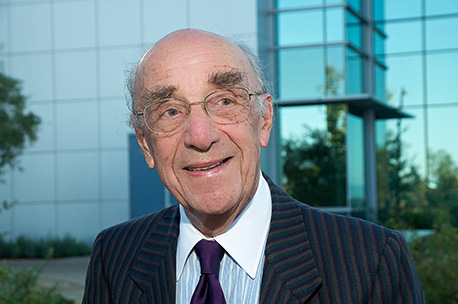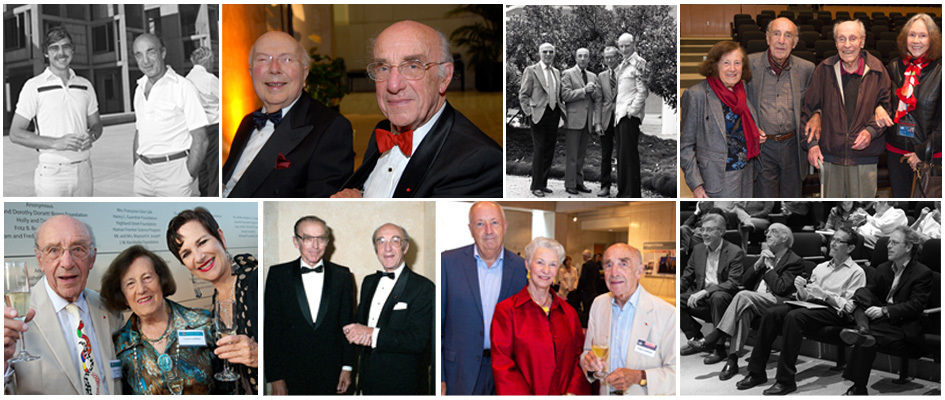
Roger Guillemin, Salk Distinguished Professor Emeritus and recipient of the 1977 Nobel Prize in Physiology or Medicine, celebrates turning 100 years old on January 11.
The neuroendocrinology pioneer is a treasured member of the Salk community, deeply appreciated both for his many achievements and for his loyal friendship and mentorship even after retirement.

“Roger is one of the world’s preeminent minds and equally one of the kindest persons you’ll ever meet,” says Salk President Gerald Joyce. “Everyone at Salk wishes Roger all the best on this very special occasion.”
Considered the founder of the field of neuroendocrinology, Guillemin’s pioneering research into brain hormones has led to treatments for disorders ranging from infertility to pituitary tumors.
Guillemin joined Salk in 1970 to head the newly established Laboratories for Neuroendocrinology. He and his group discovered somatostatin, which regulates the activities of the pituitary gland and the pancreas. Somatostatin is used clinically to treat pituitary tumors. He was among the first to isolate endorphins, brain molecules that act as natural opiates, and his work with cellular growth factors led to the recognition of multiple physiological functions and developmental mechanisms.
Guillemin played a key role in discovering the brain’s role in regulating hormones, molecules that act as chemical messengers between different parts of the body and regulate bodily functions. While scientists had long believed that the brain ultimately controlled the function of hormone-producing endocrine glands, there had been scant evidence to prove exactly how it did so.
After meticulous study of materials harvested from 1.5 million sheep brains, Guillemin and his team made a breakthrough. They discovered releasing hormones, produced in small quantities around the pituitary gland, which signal the release of other hormones. Guillemin and Andrew Schally separately extracted a sufficient amount of releasing hormone to determine its structure in 1969. They subsequently were able to produce it with chemical methods.
Their work would lead them to the 1977 Nobel Prize in Physiology or Medicine, shared also with Rosalyn Yalow for a separate but related discovery, for “discoveries concerning the peptide hormone production of the brain.”
This breakthrough resulted in the identification of a molecule called TRH (thyrotropin-releasing hormone), which ultimately controls all the functions of the thyroid gland. In the following years, Guillemin and his colleagues isolated other molecules from the hypothalamus that control all functions of the pituitary gland—for instance, GnRH (gonadotropin-releasing hormone), a hypothalamic hormone that causes the pituitary to release gonadotropins, which in turn trigger the release of hormones from the testicles or ovaries. This discovery led to advancements in the medical treatment of infertility and is also used to treat prostate cancer.
Though Guillemin retired from the lab in 1989, he remained active at Salk throughout the years. He shifted his long-standing expertise with computers from science to art and had been one of the pioneers in the expanding field of digital paintings.
In 2007, Guillemin was gracious enough to serve a term as interim president of the Salk Institute, saying, “By all criteria, the Salk Institute is one of the most prestigious biological research institutions of the country and in the world."
Prior to the COVID-19 pandemic, Guillemin kept regular office hours at the Institute, continuing to provide his time and experience to any who might seek his council.
Born in Dijon, the capital of France’s Burgundy region, Guillemin gained an interest in science early. As a child, he collected organisms, including mushrooms, for classification. He was also good with his hands, using his dexterity and intellect to build radios and transmitters. After attending public schools, he entered medical school at the Université de Bourgogne in 1943.
Guillemin’s youth and college experience was wrought with challenges—most considerable of which was the German occupation of France. During his first year of medical school, he and several of his classmates received orders to report to Munich to build weapons for the German army, but they refused.
“We all tore the thing up and said, ‘We’re going to disappear in the Underground,’” Guillemin said in a 2013 video where he reminisced about his scientific accomplishments.
Guillemin went on to earn his MD in 1949 and practiced medicine for several years before committing to research full time. He earned his PhD in physiology, with a special focus on experimental endocrinology, from Université de Montréal in 1953. Shortly after completing his PhD, Guillemin became an assistant professor of physiology at the Baylor University College of Medicine.
Guillemin was a mentor to many future leaders in endocrinology and medical research while at Baylor, including Catherine and Jean Rivier, as well as Wylie Vale, who would all follow Guillemin to Salk in 1970 and themselves join the faculty there.
For all of his accomplishments, Guillemin is always quick to point out the contributions of the many people who worked alongside him. “I have had the extraordinary privilege to work with wonderful collaborators, some so much more knowledgeable in their own field than I was (or still am), all full of enthusiasm and sharing the common ethics of science,” he wrote as he reflected on achieving the Nobel Prize.
These days, Guillemin spends his time with his family—five daughters and one son; four grandchildren; and two great-grandchildren. Now a resident of Del Mar, California, he lived for many years in La Jolla, where he was an avid collector of French and American paintings and sculptures, as well as Papuan and pre-Columbian pottery. He and his wife, Lucienne, were married for 69 years before she died in 2021 at the age of 100.

"Roger has had a very big influence on my scientific and personal life,” says Salk Professor Rusty Gage, past president of Salk. “His own contributions to science are enormous, but in addition, he has been so supportive and generous with his encouragement and advice to me and many other scientists whose lives he has touched. Importantly, he is a model for fostering the care and love of family, as reflected in his loving relationship with his late wife, Lucienne, and his remarkable children, including the wonderful Claire. I am proud to count Roger as a dear friend, colleague, and mentor."
"Roger has always been a personal inspiration,” says Professor Greg Lemke, Salk’s chief science officer. “His curiosity to understand the brain’s regulation of physiology, which was unrelenting, led to discoveries that have impacted the lives of millions."
“I’ve known Roger for 45 years now, and he is truly a trusted colleague, a good friend, and an inspirational mentor,” says Salk Professor Ronald Evans. “His pioneering discoveries of hypothalamic peptides launched the field of neuroendocrinology. He always wanted to reach 100 years of age—and now he has! Go, Roger!”
“Even before my arrival at the Salk Institute as a postdoctoral fellow in 1971, Roger had established himself as a preeminent scientist,” says Salk Professor Tony Hunter. “A few months later, his group announced their historic discovery of the somatostatin neuropeptide that blocks growth hormone release, creating huge excitement, deservedly so. Over the years Roger has been a great inspiration to me, and his discovery of somatostatin was an example of the type of groundbreaking research that has become the hallmark of the Institute. It’s hard to believe that now over fifty years later we are marking Roger’s 100th birthday. It’s an honor to celebrate his truly amazing life of science and art.”
Office of Communications
Tel: (858) 453-4100
press@salk.edu
Unlocking the secrets of life itself is the driving force behind the Salk Institute. Our team of world-class, award-winning scientists pushes the boundaries of knowledge in areas such as neuroscience, cancer research, aging, immunobiology, plant biology, computational biology and more. Founded by Jonas Salk, developer of the first safe and effective polio vaccine, the Institute is an independent, nonprofit research organization and architectural landmark: small by choice, intimate by nature, and fearless in the face of any challenge.